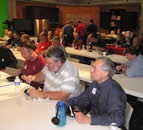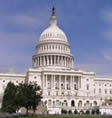News & Headlines
FCC Extends Deadline for Emergency Audio Crawls
May 26, 2015
On March 27, 2015, the NAB filed a petition requesting three limited waivers of the Audible Crawl Rule. First, the NAB requested the Commission to grant a six-month partial exemption from or limited waiver of the Audible Crawl Rule from May 26, 2015 until Nov. 26, 2015. The NAB argued that broadcasters need this extension because the hardware and software necessary for broadcasters to aurally transcribe emergency information crawls had not yet been released and delivered by vendors in many cases, and additional time is needed to test, order, ship, and install the systems developed by the vendors. Second, the NAB asked the Commission to waive the requirement that visual but non-textual emergency information be included in the aural representation of emergency information on the secondary audio stream until technological solutions are available. According to the NAB, it is currently infeasible to comply with this requirement with respect to radar maps and similar moving graphics because they do not contain text files that can be converted to speech. Finally, the NAB requested the Commission to temporarily waive the requirement to aurally convey school closing information on the secondary audio stream, while the NAB considers alternatives with input from stakeholders. On April 9, 2015, the Society of Broadcast Engineers filed comments with the FCC supporting the NAB's filing.
On May 26, the original deadline for TV stations to comply with the rule, the FCC issued a memorandum opinion and order that grants the six-month waiver until Nov. 30, 2015, of the compliance deadline for video programming distributors to provide aurally on the secondary audio stream emergency information presented visually in non-newscast programming. The record created in response to the NAB petition shows that the technical solutions necessary for broadcasters to aurally transcribe emergency information text crawls on the secondary audio stream were not developed and brought to market in time for broadcasters to test and implement such systems by the May 26, 2015, compliance deadline.
Also in the FCC order, the FCC grants an 18-month waiver of the requirement to aurally describe visual but non-textual emergency information (e.g., maps or other graphic displays), but limit this waiver to 18 months. The NAB and the broadcast commenters argue that radar maps and similar moving graphics do not contain text files that can be converted to speech and, therefore, an automated text-to-speech (TTS) system cannot be used to aurally describe them. The FCC also states that visual but nontextual emergency information is generally duplicative of emergency information contained in an accompanying on-screen crawl, which would be aurally transcribed on the secondary audio stream.
The FCC has waived the requirement to include school closings information aurally on the secondary audio stream while it reconsiders the requirement in the Second FNPRM. The NAB argues that an alternative solution is needed because audible crawls of school closings would be "prolonged and inefficient" and would "crowd out more important emergency information." All comments on this issue support this waiver while the Commission and interested parties consider more efficient alternatives. We find that a one-year time limit is unnecessary given the Commission's commitment to work with stakeholders to resolve this issue expeditiously, as evidenced by adoption of the Second FNPRM last week.
While this FCC order extends the deadline for TV stations to implement the technology, stations should continue evaluating and installing systems to comply with the new audio crawl deadline. The SBE, the NAB and other groups will continue working on solutions for the school closings and graphics issues.









